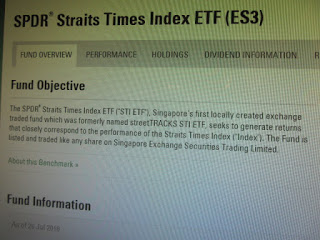I am feeling lazy, as always, and didn't want to write about the new REIT ETF but I received so many messages that I decided, maybe, I should say something.
I didn't want to blog about the ETF because it is easy enough to understand.
It will hold a basket of REITs, 23 to be exact, from countries such as Singapore, Hong Kong and Malaysia.
It will distribute income quarterly and the distribution yield is estimated to be 5% at IPO.
The ETF is probably a good choice for people who want to have exposure to REITs but are too lazy to be bothered with researching individual REITs.
OK, I understand the lazy bit but they will have to take the good with the bad in the ETF.
For people who know more about REITs, they are probably better off investing in individual REITs.
I don't know about you but a 5% distribution yield from a REIT product is unattractive to me.
Why?
Well, remember that REITs are leveraged instruments.
Leverage magnifies gains.
So, the 5% yield is after magnification.
Taking into consideration that they distribute 90% to 100% of their cash flow (i.e. they have zero retained earnings), a 5% yield doesn't seem attractive.
To me, the only good thing about the ETF is that having a portfolio of 23 REITs reduces concentration risk.
However, if diversification is what we want, we can try to form our own REIT ETF.
Taking from my portfolio, for example, we could put together an "AK REIT ETF":
1. AIMS AMP Cap. Ind. REIT
2. FIRST REIT
3. Frasers Log and Ind. Trust
4. Ascendas Hospitality Trust
5. IREIT Global
6. Croesus Retail Trust
7. Religare Health Trust
OK, I am being a bit liberal here since not all are REITs but you get the idea.
Assuming equal weight given to the 7 components in "AK REIT ETF", we are looking at a distribution yield of more than 7%.
"AK REIT ETF" would generate at least 40% more in income than "NikkoAM-Straits Trading ex-Japan REIT ETF".
Oh, did you notice that my REIT is also less of a mouthful?
Yes, I know.
Bad AK! Bad AK!
Of course, we would also have control of what we want in and what we want out.
We could also change the weight of each component.
If we are investing in REITs for income, if we want some diversification, then, perhaps, NikkoAM-StraitsTrading ex-Japan REIT ETF is a decent option.
Otherwise, the ETF really doesn't seem attractive to me at all.
-------------------
UPDATE (16 March 2017):
What happens if one of the REITs (or a few) in the ETF had a rights issue?
A reader found out from the horse's mouth:
"Investors in the ETF have no direct access to the rights issues.... Manager has the discretion whether to take up the rights/sell the rights..."
Ron and Dave dissect some of today’s most important REIT ETFs.






























